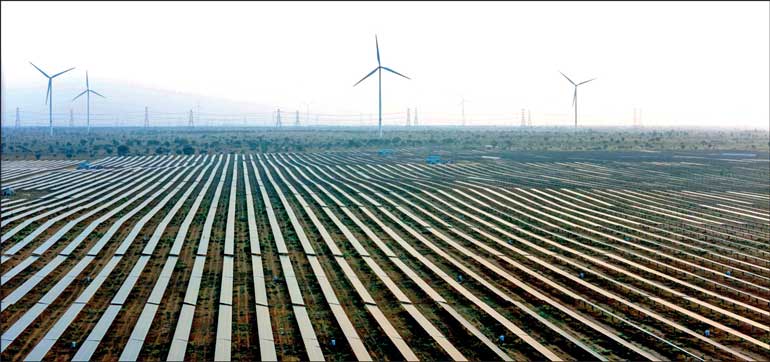Friday Jan 16, 2026
Friday Jan 16, 2026
Wednesday, 22 May 2024 00:22 - - {{hitsCtrl.values.hits}}

 I concluded a recent article on renewable energy saying, “the conversation should continue, but in a more sober, evidence-based manner” (https://www.ft.lk/columns/Electricity-sector-Without-investment-we-will-be-in-the-dark-again/4-761485). I was surprised by the ferocity of the response that went beyond countering my arguments (https://www.ft.lk/columns/Electricity-sector-What-Rohan-Samarajiva-didn-t-say/4-761731).
I concluded a recent article on renewable energy saying, “the conversation should continue, but in a more sober, evidence-based manner” (https://www.ft.lk/columns/Electricity-sector-Without-investment-we-will-be-in-the-dark-again/4-761485). I was surprised by the ferocity of the response that went beyond countering my arguments (https://www.ft.lk/columns/Electricity-sector-What-Rohan-Samarajiva-didn-t-say/4-761731).
I had stated, “we can be happy that environmental impact assessment is considered non-negotiable in Sri Lanka.” I was accused of wanting to get rid of environmental impact assessments and wanting to violate the Constitution and the laws of the land. But this is not unusual in these polarised and untrusting times: if someone questions my position however politely, it must be because that person is an apologist for some perfidious foreign entity.
My intention here is not to engage in a point-by-point refutation. My broader objective of getting people to think more clearly about the conditions for private investment and risk is unlikely to be achieved by such a response. What I would like to do here is to see how the conversation can be continued.
Speaking truth counter to populist sentiment
It is said that speaking truth to power is difficult. My experience is that it is equally difficult to deviate from populist sentiment. Lower prices are better than high prices in all circumstances, especially when foreign investors are involved. Those who say otherwise should be pilloried. That’s the populist sentiment.
But sometimes, higher prices are necessary. I have not then or now justified the 8.26 USD cents price approved by Cabinet for the Adani project. I do not have the evidence to make such as assessment. In the article that was written before the decision was announced I only questioned reliance on US and Indian price points as useful benchmarks. My article suggested that the costs (and therefore the prices) here would be higher.
I have done similar things contrary to populist sentiment in the past. One of the hardest things I did as Director General of Telecommunications 26 years ago was to raise the monthly rental for fixed phone connections from Rs 100 to 180 along with call charges. As part of the privatisation of Sri Lanka Telecom the government had promised the Japanese investor to “approve adjustments to rentals, call charges, and connection charges in a manner that would yield a minimum 148 percent increase in domestic revenue (not adjusted for inflation) over a five-year period.” This was because the company was abnormally dependent on rapidly declining international call revenues. Investment was needed in the domestic network, but at the existing cross-subsidised prices it made no sense for SLT or the competitors. However unpleasant and contrary to populist sentiment, the revenue from domestic calls had to be increased.
I believed the already high connection charges (minimum of Rs. 14,000) should not be increased so more people could get phones. That left no alternative but to raise rentals and call charges. The few who already had phones were vocal and powerful. Those who had been on waiting lists for years were voiceless. But we did it and survived the storm. Investments were made by SLT and the others. The foreign investor did not pull out. Connections increased by over 50% year-on-year. Waiting lists were eliminated in a few years. The sector and the company thrived.
The regulator was there to take the right decisions politicians could or would not take, based on the best available evidence. Here the tough decisions are being taken directly by the minister and by Cabinet. It is fine to examine the evidence used to justify the decisions. It is also necessary to question criticisms of the decisions. That is the needed conversation that will help us get to the best evidence and clarify the tradeoffs that are being made.
What is the right price?
Sri Lankan unit prices for electricity from wind have to be higher than those in India for the reasons explained in the previous article. Because no price discovery process was implemented for these two sites, there is no alternative to negotiation. Negotiation based on cost data submitted by the investor is difficult without recourse to benchmarks. If international benchmarks are problematic because of higher risk factors, etc., are there domestic ones?
Without doubt, Sri Lankan benchmarks are superior to foreign ones. The costs of the operational CEB wind plant in Mannar are useful, even though it had favourable credit terms from ADB and a discount from Vestas which wanted to gain a foothold in the market. These elements, among others, may be used to adjust the benchmark. Many people are asking me about the bids made for a 50 MW wind power auction.
There is value in benchmarking a completed project rather than prices revealed by an auction because there are many recent instances of successful bidders pleading for price revisions or not proceeding with the award in Sri Lanka as well as abroad. In theory, auctions are the best ways to discover prices. That is what I teach (and what I said in the previous article). But it is necessary to look at the reality on the ground too.
It is a peculiarity of the Sri Lankan environment that a bid is considered the opening move in a series of negotiations with the State and with those who can provide the investment funds. I am told that many solar bidders have asked for higher-than-bid prices, some asking for prices above negotiated wind prices. If it is shown that most previous renewable energy auction bids have not been renegotiated, or if the ministry can assure that the Mannar bids will result in working wind farms without renegotiated prices, the auction prices may suffice, subject to corrections due to the different sizes and locations, and other relevant factors. It would be useful to identify the data that can be used by the Government in the negotiation. These are usually the tasks of consultants supervised by ministry or regulatory officials with the required competencies. The Adani agreement dates back to 2021. The ministry had the time to work up a proper benchmarking methodology. Perhaps the problem is a lack of will and capacity.
I was speculating about the transmission component. I have been informed that transmission in this instance is handled outside the generation proposal, though it has to be closely coordinated to prevent recurrence of what happened with an early wind project. The turbines were turning but the electricity could not be taken by the grid. It is possible that the reported lack of progress on the $ 1.7 billion Poonakary solar project (which did not attract much criticism despite being awarded without a competitive tender) may be explained by delays in the finalisation of the common transmission link for that project and the Pooneryn windfarm. I am also told that the line beyond Nadukudah has adequate capacity.
How can the conversation continue?
The above discussion on transmission illustrates how. One participant in the conversation says something; others contribute better-quality information; corrections are made; and the conversation proceeds with better evidence. I suggested the CEB wind project in Mannar could serve as a starting point for a proper benchmark. Someone may show that it was padded with unnecessary expenses such as multiple circuit bungalows. The benchmark would have to be reduced accordingly.
Another way is to call people names, claim they said the opposite of what they said, and otherwise demonise them.
I leave it to the reader to decide which option is more productive.